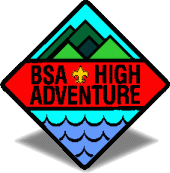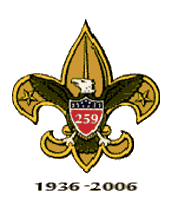|
|
|
|
|
The Boy Scouts of America is pleased to share the following suggestions—adapted from Your Flag, published by the Boy Scouts of America—to help you properly display and care for your symbol of our nation's unity, glory, and resolve.

Troop 259
|
|||||||
Flying the Colors The U.S. Flag Code, adopted in 1923 and amended by Public Law 94-344 in 1976, states "It is the universal custom to display the flag only from sunrise to sunset ... However, when a patriotic effect is desired, the flag may be displayed 24 hours a day if properly illuminated during the hours of darkness." When flags or pennants of states, cities, or societies are flown with the national flag on the same halyard, the U.S. flag should fly at the peak, above all others. If other flags are flown from adjacent staffs, the U.S. flag should always be to the right of all others and should be hoisted first and lowered last. Flags of other nations must be flown from separate flagpoles of equal height, and all flags should be approximately equal in size with the U.S. flag. International usage forbids the display of the flag of one nation above that of another nation in time of peace.

Troop 259
|
Displaying the Flag
When displayed from a staff projecting from a windowsill, balcony, or the front of a building, the union (blue field) should be at the staff's peak (unless the flag is at half-staff).
The U.S. Flag Code, adopted in 1923 and amended by Public Law 94-344 in 1976, states "It is the universal custom to display the flag only from sunrise to sunset ... However, when a patriotic effect is desired, the flag may be displayed 24 hours a day if properly illuminated during the darkness hours.
When displayed on a stage or platform, the national flag should be to the speaker's right. Any other flag is on the speaker's left.
When suspended, the flag should be vertical with the union to the north over an east-west street and to the east over a north-south street. The flag should be hoisted out union (blue field) first.
Flag decals and stickers may be correctly displayed on the inside of motor vehicle side windows

Troop 259
|
||||||
Flying the Flag at Half-Staff
Before the flag is lowered for the day, it is raised again to the top, then lowered.
If your flag is on an outrigger flagpole or mounted on a wall and cannot be flown at half-staff, it is appropriate to drape a purple and black mourning ribbon across the flag. 
Troop 259
Wearing the Flag
Flag lapel pins should be worn on the left lapel near the heart.
Reproductions of the national flag in any medium such as jewelry, pins, buttons, or printed materials must show the union (blue field) on the top and to the observer's left when facing the flag.
Troop 259
|
|||||||
2. Then fold it in half again.
3. Bring the lower striped corner to the upper edge, forming a triangle.
4. Then fold the upper point in to form another triangle. Continue until the entire length of the flag is folded.
5. When you get near the end—nothing but the blue field showing—tuck the last bit into the other folds to secure it.
6. The final folded flag resembles a cocked hat with only the white stars on a blue field showing.
Troop 259
| |||||||
Celebrating Flag Day The History Of Flag Day
On June 14, 1889, George Balch, a kindergarten teacher in New York City, planned appropriate ceremonies for the children of his school, and his idea of observing Flag Day was later adopted by the State Board of Education of New York. On June 14, 1891, the Betsy Ross House in Philadelphia held a Flag Day celebration, and on June 14 of the following year, the New York Society of the Sons of the Revolution, celebrated Flag Day.
Following the suggestion of Colonel J Granville Leach (at the time historian of the Pennsylvania Society of the Sons of the Revolution), the Pennsylvania Society of Colonial Dames of America on April 25, 1893 adopted a resolution requesting the mayor of Philadelphia and all others in authority and all private citizens to display the Flag on June 14th. Leach went on to recommend that thereafter the day be known as 'Flag Day', and on that day, school children be assembled for appropriate exercises, with each child being given a small Flag.
Two weeks later on May 8th, the Board of Managers of the Pennsylvania Society of Sons of the Revolution unanimously endorsed the action of the Pennsylvania Society of Colonial Dames. As a result of the resolution, Dr. Edward Brooks, then Superintendent of Public Schools of Philadelphia, directed that Flag Day exercises be held on June 14, 1893 in Independence Square. School children were assembled, each carrying a small Flag, and patriotic songs were sung and addresses delivered.
In 1894, the governor of New York directed that on June 14 the Flag be displayed on all public buildings. With BJ Cigrand and Leroy Van Horn as the moving spirits, the Illinois organization, known as the American Flag Day Association, was organized for the purpose of promoting the holding of Flag Day exercises. On June 14th, 1894, under the auspices of this association, the first general public school children's celebration of Flag Day in Chicago was held in Douglas, Garfield, Humboldt, Lincoln, and Washington Parks, with more than 300,000 children participating.
Adults, too, participated in patriotic programs. Franklin K. Lane, Secretary of the Interior, delivered a 1914 Flag Day address in which he repeated words he said the flag had spoken to him that morning: "I am what you make me; nothing more. I swing before your eyes as a bright gleam of color, a symbol of yourself."
Inspired by these three decades of state and local celebrations, Flag Day - the anniversary of the Flag Resolution of 1777 - was officially established by the Proclamation of President Woodrow Wilson on May 30th, 1916. While Flag Day was celebrated in various communities for years after Wilson's proclamation, it was not until August 3rd, 1949, that President Truman signed an Act of Congress designating June 14th of each year as National Flag Day.

Troop 259
|


 Troop 259
|